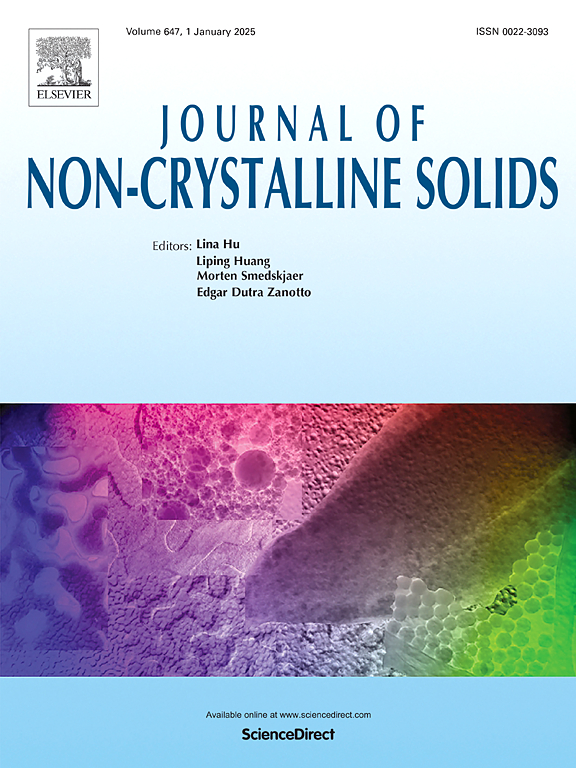低碱度CaO-SiO2-10wt的粘度和结构。% FeOx-10wt。% P2O5渣系统
IF 3.5
3区 材料科学
Q1 MATERIALS SCIENCE, CERAMICS
引用次数: 0
摘要
炉渣粘度是影响二氧化硅改性剂在碱性氧炉(BOF)熔渣中溶解的关键因素,尤其是在在线改性过程中。本文采用旋转圆筒法测定了低碱度cao - sio2 - 10wt .% fe2o3 - 10wt .% P2O5渣的粘度。利用多光谱技术对玻璃渣样品的结构进行了分析,以更好地了解渣粘度与结构之间的关系。结果表明,随着二元碱度(CaO wt.%/SiO2 wt.%)从1.46降低到1.16,渣黏度增大,计算的表观活化能从147.57增加到161.78 kJ·mol−1。x射线光电子能谱(XPS)、傅里叶变换红外(FT-IR)、拉曼光谱(Raman)和29Si固态魔角自旋核磁共振(MAS-NMR)结果表明,渣的聚合度(DOP)随渣碱度的降低而增加,这与粘度随碱度的变化相一致。因此,随着炉渣中二氧化硅含量的增加,二氧化硅改性剂的溶解会变差。此外,31P固态MAS-NMR表明,磷存在于孤立的正磷酸盐(Q0(P))结构单元中。结果表明,由于铁离子的顺磁效应,29Si固态MAS-NMR在含铁硅酸盐玻璃的结构定量中受到限制。本文章由计算机程序翻译,如有差异,请以英文原文为准。
Viscosity and structure of low basicity CaO-SiO2–10wt.% FeOx-10wt.% P2O5 slag system
Slag viscosity is a crucial factor affecting the dissolution of silica modifiers in molten basic oxygen furnace (BOF) slag, particularly during the online modification process. In this work, the viscosity of low basicity CaO-SiO2–10 wt.% Fe2O3–10 wt.% P2O5 slag was measured by the rotating cylinder method. The structure of glassy slag samples was analyzed by multiple spectroscopic techniques to offer a better understanding of the relationship between slag viscosity and structure. It is concluded that the slag viscosity increases with decreasing binary basicity (CaO wt.%/SiO2 wt.%) from 1.46 to 1.16, and the calculated apparent activation energy increases slightly from 147.57 to 161.78 kJ·mol−1. The results of X-ray photoelectron spectroscopy (XPS), Fourier transformation infrared (FT-IR), Raman spectroscopy, and 29Si solid-state magic angular spinning nuclear magnetic resonance (MAS-NMR) reveal that the degree of polymerization (DOP) of slag increases with decreasing the slag basicity, which is consistent with the viscosity variation with basicity. Therefore, the dissolution of silica modifier would be deteriorated as silica content in slag increases. In addition, the 31P solid-state MAS-NMR demonstrates that phosphorous exists in isolated orthophosphate (Q0(P)) structural unit. It was shown that 29Si solid-state MAS-NMR is limited in the structural quantification of Fe-bearing silicate glasses due to the paramagnetic effect of iron ions.
求助全文
通过发布文献求助,成功后即可免费获取论文全文。
去求助
来源期刊

Journal of Non-crystalline Solids
工程技术-材料科学:硅酸盐
CiteScore
6.50
自引率
11.40%
发文量
576
审稿时长
35 days
期刊介绍:
The Journal of Non-Crystalline Solids publishes review articles, research papers, and Letters to the Editor on amorphous and glassy materials, including inorganic, organic, polymeric, hybrid and metallic systems. Papers on partially glassy materials, such as glass-ceramics and glass-matrix composites, and papers involving the liquid state are also included in so far as the properties of the liquid are relevant for the formation of the solid.
In all cases the papers must demonstrate both novelty and importance to the field, by way of significant advances in understanding or application of non-crystalline solids; in the case of Letters, a compelling case must also be made for expedited handling.
 求助内容:
求助内容: 应助结果提醒方式:
应助结果提醒方式:


